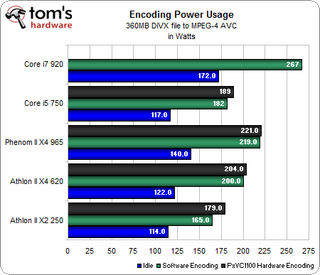The WinFast PxVC1100 Video Transcoding Card: Worth The Price?
CPU And Power Usage Benchmarks
The CPU-usage benchmark shows us just how much of the load the SpursEngine is taking off of the CPU:

Only the dual-core Athlon II X2 utilizes more than 60% of its resources when the WinFast PxVC1100 card is handling encoding, while all of the quad-core CPUs have compute headroom to spare. Contrast this with the CPU-only encoding, where only the Core i7-920 processor is using less than 90% of its total processing capacity.
These are impressive numbers, suggesting that a PC using the SpursEngine could still be used for other tasks while encoding. This is not something that a CPU-only solution would comfortably allow. Truly, this is probably the largest real-world benefit of the WinFast PxVC1100.
We can see the performance and CPU usage benefits, but what about the power usage of the WinFast card?

The WinFast board hardly makes a dent in overall power consumption. Even though the SpursEngine is likely drawing at least 10W under load, consider that the CPU is drawing less power while the add-in board is shouldering the workload. The end result is a relatively flat power result, despite the dramatic performance increase.
Stay on the Cutting Edge
Join the experts who read Tom's Hardware for the inside track on enthusiast PC tech news — and have for over 25 years. We'll send breaking news and in-depth reviews of CPUs, GPUs, AI, maker hardware and more straight to your inbox.
Current page: CPU And Power Usage Benchmarks
Prev Page Image Quality Comparison Next Page Conclusion: Encoding Performance Per Dollar-
paxiam I think for someone who does use their PC for encoding on a regular basis, this would certainly be a welcome addition, but otherwise, forget it.Reply -
paxiam I think for someone who does use their PC for video encoding on a regular basis, this would certainly be a welcome addition (the price is reasonable), but otherwise, forget it.Reply -
SpadeM These miscellaneous type of articles is what brightens up my day. Good to know that there aren't many products that launch and slip between the cracks of processor/graphics wars. Great job, nice article!Reply -
kumaiti Any info on future software support for this card? This card would be extremely useful if plug-ins for other video editor could be made.Reply -
4745454b Considering AMD has all but abandoned AVIVOm, the better question to ask is how this compares to CUDA. From what I've seen there aren't any problems with the output file. $200 is a bit much but at least it comes with the software. For those that have the $$$ to spare and do the encoding work, this is a big time saver. You could get the 620, mobo, and the card for probably about the same price as the 920 and a good Mobo. The difference is this setup will encode faster, and you can use the computer to do other things while encoding. I don't remember 100% for sure about it, but I think it will use less power as well.Reply -
apache_lives hmmm get the feeling this will go the way of the dedicated physx (only) cards...Reply
what we need is a more GENERALISED co-processor card/device for this type of workload and many other uses, Intel's Larrabee had a good *idea* going - easily programmable, multi-purpose etc -
g00ey I was rather thinking that this hardware could be useful in portable media players where it is designed to consume less power and allow playback of all video formats out there.Reply
Moreover, this could also be useful in HD video cameras that are either stand-alone HD video cams or fitted into mobile phones (such as the Samsung Omnia HD) or digital snapshot cameras.
I'm also thinking about its capabilities to be used in Live video applications that is streamed over the internet, either professional or teleconference applications such as SkypeHD.
Most Popular

